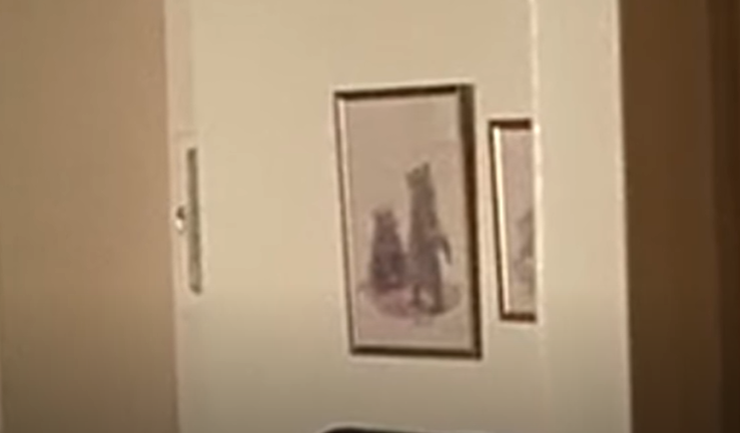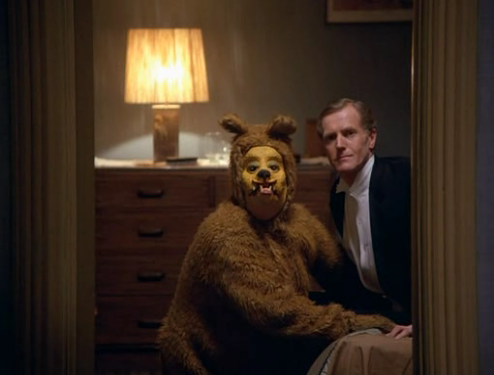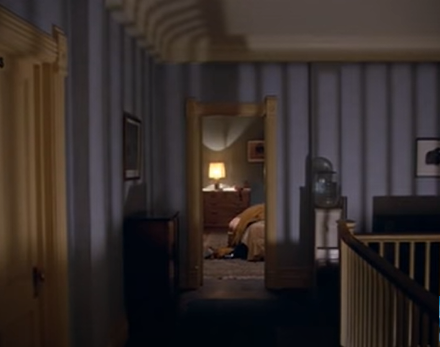A notoriously disturbing moment in The Shining (1980) is the ‘bear costume’ scene, which poses questions why Kubrick specifically chose this animal and its symbolic purpose in this bizarre shot.
The cheap appearance, thus inauthenticity of the costume, intentionally reminds viewers of the human inside the outfit, removing its animality in favour of humanity and suggesting the bear represents an abstract notion rather than a real animal. Bears are often perceived as emblematic of childhood through their link to teddy bears and the disproportionate, fake-fur costume strongly resembles this classic toy. The bear costume therefore becomes uncanny and likely representational of the haunted child Danny; the lewd sexual act it performs connotes the destruction of Danny’s childhood and innocence.

Whilst bear imagery is prominent in the film through manipulation of mise-en-scene, the bear costume shot significantly echoes the brief camera focus upon the artwork above Danny’s bed in an earlier scene (Fig 1). In the image, two bear figures mimic the bear-costumed character and its partner’s position. The artwork’s location in Danny’s bedroom has clear sexual connotations, linking to the sexual act the bear-costumed character is performing and further supports the idea that the bear symbolises the corruption of Danny’s childhood, particularly the heavily implied sexual abuse he endured from his father.
The artwork’s frame is subsequently paralleled by the door frame and the camera is unable to zoom in closer to the bear-costumed character as it cannot transcend the door’s borders (Fig 2). By presenting this shot in a similar format to the artwork, it demands viewers visually violate themselves through witnessing the bear-costumed character’s sexual act to comprehend the disturbing metaphorical exploitation of childhood and sexual abuse suffered by Danny. The utilisation of a POV shot from Wendy’s position as she approaches the room causes viewers to be wary of what will be discovered inside. The stillness of the camera feels unnatural when it immediately follows the rapid moving shot of a panicked Wendy ascending the stairs, indicating something is grossly amiss. However, providing viewers with Wendy’s perspective also enables them to identify with her shocked realisation of the horror contained within the room.

Figure 2: The close up shot of the bear-costumed character and its partner.
The dramatic silhouette of the stair bannisters across the corridor has the similar effect of entrapment as the door frame (Fig 3). The striped shadows emulate the bars of a cage, resembling a zoo enclosure; this illusion links to the very public display of the bear-costumed character performing fellatio, similar to how an animal exhibited in a zoo is observed. However, as the silhouette is cast onto the walls surrounding Wendy (and therefore viewers, who are placed in Wendy’s perspective), this striking lighting feature accentuates the greater premise of both Wendy and viewers being simultaneously trapped and watched within the hotel walls. Entrapment additionally occurs from being unable to divert attention from the sexual act depicted in this shot, emphasised by the intense zoom-in. Whilst the ‘shadow cage’ compels Wendy and viewers into voyeurism, they are nevertheless exposed to being watched themselves. The bear-costumed character looks directly at the camera before their partner sits up and the full extent of the sexual act is realised; this creates further feelings of uneasiness and vulnerability for Wendy, and thus viewers, not only through this sexual taboo, but also now two piercing stares outnumber the singular gaze of Wendy or the viewer. The roles have switched from normal expectation of a human-animal interaction as the ‘animal’ observes the human and, despite its grotesqueness, the shot is almost comical.

Figure 3: The initial long shot depicting the bear-costumed character. The silhouette of the stair bannisters is emphasised, along with the bare behind of the bear costume.
Viewers are made to feel bare in this almost unbearable scene; Kubrick disturbs yet strangely humours viewers with the notion of ‘bear’ and perhaps chose this animal for its links to gay subculture. The bear costume’s noticeably bare behind is a visual pun for this, but can perhaps be analysed further with the notion of a ‘bare faced-lie’, in light of the many deceptions in the film (Fig 3).
Filmography
Kubrick, Stanley, The Shining (Warner Brothers, 1980)